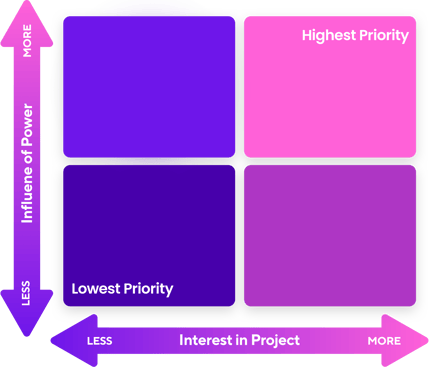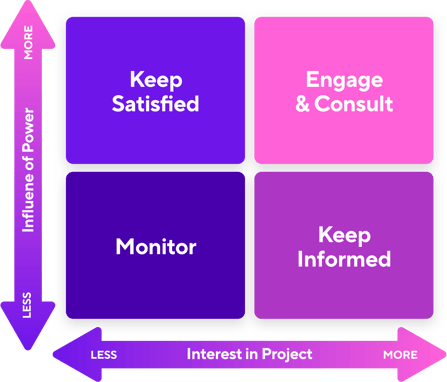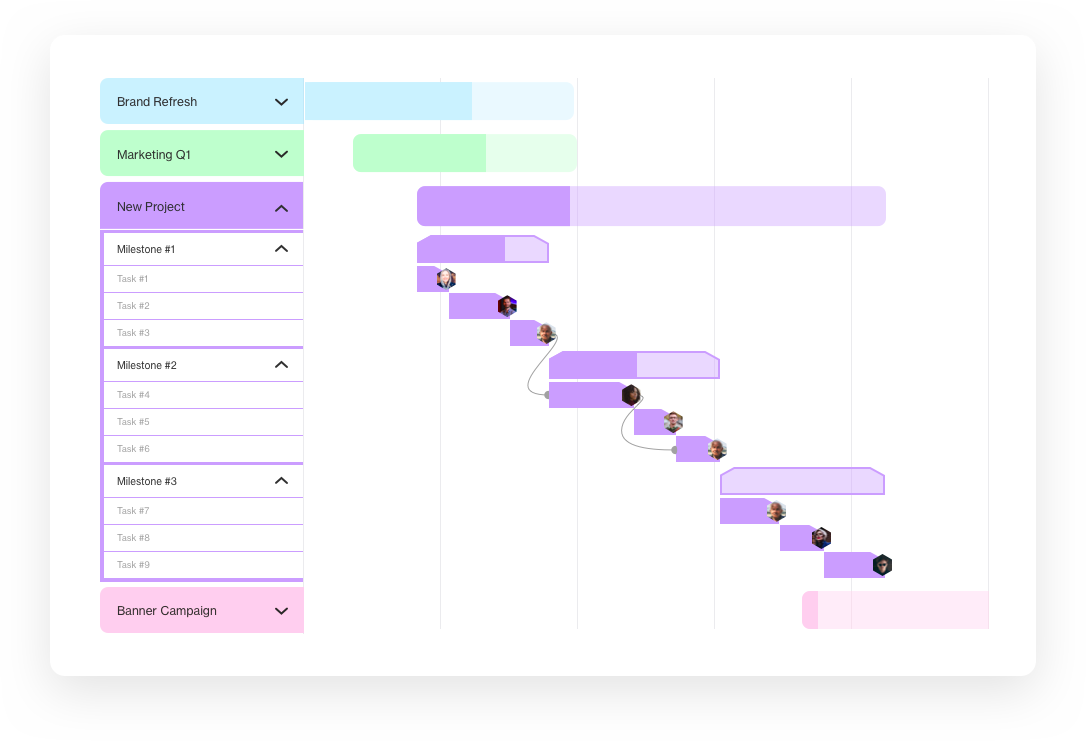Stakeholder Management: How to survive in 2022

Managing stakeholders is one of the most delicate and tricky tasks that Project Managers will undertake. It’s a balancing act between different priorities, motivations and expectations. But effective stakeholder management can’t be sidelined: it is essential to the health of your project. Ignoring the role of stakeholders is a proven path to disaster.
In October 2020, Germany opened a new airport in Berlin, built to be Berlin’s primary airport. Late 2020 seems like an unusual time to open a new airport, with international travel so heavily restricted by the pandemic. But by October 2020, the project was already nine years late and billions of euros over budget. The building of the airport was dogged by disasters from the very beginning. And many of the problems arose due to poor stakeholder management.
But even the best-laid plans can be derailed by difficult stakeholders. You can deliver a project to spec, on time, and within budget - but if your key stakeholders are not satisfied, the project is not a success.
Take the time to arm yourself with a robust stakeholder management strategy to avoid this challenging area of project management from getting the best of you.
- What is a Stakeholder in a Project?
- Who Are the Stakeholders in a Project?
- Internal Stakeholders vs. External Stakeholders
- Dealing with Challenging Stakeholders
- Why You Need a Stakeholder Management Plan
- How to Create a Stakeholder Management Plan
- Stakeholder Analysis: Understand Which Stakeholders to Prioritize
- Turn Your Analysis into Action
What is a Stakeholder in a Project?
A stakeholder is any group or individual who can affect or is affected by your project. The idea of a stakeholder in business was first advanced in the 1960s, when management theorists started to understand that businesses were growing increasingly larger and more complex. The relationship between business and stakeholder was defined by dependence, as neither one could achieve their goals without buy-in from the other.
A project stakeholder can be thought of in the same way. The project can’t succeed without buy-in from the stakeholders, and the stakeholders can’t get what they want from the project without their goals being considered.
Who Are the Stakeholders in a Project?
Who your stakeholders are, and how much involvement they need or expect, will depend entirely on the project. Large construction projects are notorious for having numerous stakeholders with often competing interests. But your project might also fall into this territory, particularly with enterprise-level projects that stand to affect everyone in an organization to some degree.
Internal Stakeholders vs. External Stakeholders
To find your internal stakeholders, look within your organization. Anyone within your organization who is involved with your project is an internal stakeholder.
For example, this might include:
- Project Managers
- The project team
- Senior Management
- Executives
- Board members
However, anyone with an interest in your project who is not a member of your organization is an external stakeholder. The customer is central external stakeholder occupying the minds of private enterprises selling their services. But depending on the project, your external stakeholders may also include:
- End users
- Members of the public
- Investors, sponsors, or financiers
- Contractors or suppliers
Dealing with Challenging Stakeholders
Difficult stakeholders are a major cause of stress for Project Managers. When Dr. Christine Unterhitzenberger interviewed a number of Project Managers for the Association for Project Management, she found that PMs face a gamut of responses from difficult stakeholders, from apathy and resistance, to outright hostility. It’s no surprise, then, that dealing with challenging stakeholders can really impact the wellbeing and professional self-confidence of Project Managers.
However, though being questioned and confronted by a stakeholder may be uncomfortable, not all challenge is negative. Don’t look at difficult stakeholders as bothersome nay-sayers: they might help you to consider new ideas, or factors that might have otherwise escaped your notice.
It is worth remembering that each stakeholder has their own perspective, informed by their background and expertise. A consistently challenging stakeholder may have completely valid reasons for their concerns, and the issue may simply be that these concerns haven’t been addressed sufficiently. As Dr. Unterhitzenberger puts it: “it is important to understand that there isn’t simply a “difficult stakeholder”. It is about understanding the reasons why a stakeholder might appear to be difficult and then analyzing the impact of the difficulty."
This is not to say that clashes of personality never happen. But if you are continually facing challenge from particular individuals, try to reflect from their perspective: what is their stake in the project, and how have you communicated with them up to this point? How much information have they been given, compared to how much information they might want? They may feel that their needs are not being met.
By creating a stakeholder management plan before your project starts, you can proactively build stakeholder management check-in points and tasks into your wider project plan.
Why You Need a Stakeholder Management Plan
Cast your mind back to the Berlin Brandenburg Airport. It was a huge construction project, occupying a large site just outside of Berlin, and involving public sector and private sector actors.
The number of stakeholders was vast. Everyone from the government, to investors, to retailers, to the people of Berlin who happened to live under the flight path had a vested interest in the project. And - as is typical of a project with multiple stakeholders - not all of their interests lined up. Some wanted the airport operational as soon as possible; some didn’t want it there at all.
The various conflicting interests of the stakeholders were not managed well. And, in response, they took action. The airport authority actually ended up in several expensive lawsuits, being sued, among other things, for lost business opportunities, and for the cost of soundproofing the homes of local citizens. Not only did this ultimately contribute to the cost of the project, but the terrible PR damaged public trust in the project.
This is a helpful example of what can happen when a stakeholder feels that their input is being sidelined or ignored. You can’t rely on them to just go quietly and move out of the way while the project progresses. They may seek other avenues to have their voice heard, in ways that you don’t have any control over. And their negativity may have a ripple effect, particularly if they are an influential character in your organization.
Ignoring stakeholders where their interests conflict might sound like the easier option, but it is simply too risky. You need to plan deliberately to make sure you are balancing the interests of your stakeholders. Of course, you do have to prioritize where necessary, and some stakeholders have more sway than others. But, equally, you should aim to make sure that no one feels ignored.
How to Create a Stakeholder Management Plan
Your approach for dealing with a stakeholder will depend on their position in relation to the project. If the stakeholder is part of your organization - an internal stakeholder - you can communicate with them quite differently to how you would a customer or a member of an external professional body.
But you have less control over your external stakeholders. Depending on your relationship with these stakeholders, you may have to avoid frank conversation and find more subtle ways of managing any issues that arise. Thorough planning and mitigation are crucial if you are facing difficulties with your external stakeholders.
However, as a Project Manager, you also have a laundry list of other tasks that need to be addressed in addition to stakeholder management. This means that your method for handling stakeholders needs to be both thorough and efficient. You need to be effective in this function, but you can’t afford for it to take up all of your time.
Best practices recommended by the Project Management Institute include conducting a stakeholder analysis, and using this as the backbone of your stakeholder management strategy throughout your project. By undertaking this analysis, you can make sure that none of your stakeholders get left out, while also prioritizing the parties with most investment in and influence on the project.
Stakeholder Analysis: Understand Which Stakeholders to Prioritize
By following these steps, you can conduct a stakeholder analysis that will help you build a robust plan for managing your stakeholders:
- Identify your stakeholders
List everyone, both internal and external stakeholders. Don’t miss anyone out at this point. Even if the list looks overwhelming, remember that you won’t have to dedicate an equal amount of time and attention to everyone, but everyone does need to be taken into consideration. - Ask the Following Questions about Your Stakeholders
a. How much influence or power do they have over the project?
b. How much interest do they have in the project?
Assign a score from 1 to 10, where 1 is ‘not at all’ and 10 is ‘a lot’. The answer to these two questions will guide your approach to this stakeholder, and give you an indication of how much priority they should take. - Plot Your Stakeholders on the Stakeholder Analysis Matrix
Customers will most likely score very highly for both influence and interest. They are paying for the project, and they are very interested in the quality of deliverables. Because they have both high influence and high interest, this makes them a high priority stakeholder. On the stakeholder analysis matrix, they would sit in the top right-hand quadrant.
Other stakeholders might be harder to place. They may score highly for one question, but not the other. For example, an external agency involved in compliance or regulation might have a high level of potential power and influence over the project. But their level of interest in your specific project might be considerably less: your project may be one of many that they are involved in, and not necessarily a priority for them. In this case, you would put them in the top left-hand quadrant - high influence, but low interest.

- Use Your Matrix to Determine What Each Stakeholder Needs
Now you can clearly see which stakeholders are your highest priority, your lowest priority, and everything in between. Naturally, your highest priority stakeholders should be the focus of your attention. They should be engaged as key collaborators, given plenty of opportunity for their steer on the project. Your lowest priority stakeholders, on the other hand, require the least involvement and information. Though they should not be forgotten, they clearly do not need to be the focus of your strategy.
The remaining two quadrants represent people who either have high interest in the project but little influence on the development and outcome of the project, and people who could have significant power over the project, but have little interest in the particulars.
Though your high-interest/low-influence stakeholders won’t be steering the project, they will start to become frustrated if they feel shut out of the project process altogether. They might have concerns about the potential negative impacts of the project. A member of the project team might fall into this category: they might not be a decision-maker, but their work-life is likely to be significantly impacted if, for example, the project overruns. By providing these stakeholders with quality information and frequent updates, you can mitigate their concerns.
Finally, your low-interest/high-influence stakeholders also need to be managed differently. If they aren’t happy, they could use their high level of influence over the project to really throw a spanner in the works, or in some cases pull the plug altogether. These stakeholders don’t want to see the day-to-day detail of the project work, but they are likely to have key metrics or non-negotiables in relation to the project. High-level information is what these stakeholders need, and even then they may not need to see it very frequently.

Turn Your Analysis into Action
Completing your stakeholder analysis helps you understand what kind of approach and level of attention each stakeholder requires, but how do you turn this into an actionable plan?
When you come to map out your project plan, you can write stakeholder management tasks into the overall plan. Informed by the matrix completed in your stakeholder analysis, you can ensure that the tasks you are designing are both suitable for the intended stakeholder, and that they occur at an appropriate frequency.
For example, your low-interest/high-influence stakeholders might be satisfied with a quarterly meeting to review key metrics, but this is unlikely to be enough engagement for your high-interest/high-influence stakeholders. In the same way, more interested stakeholders might want more reports, but this needs to be factored into resourcing to avoid overworking the project team.
Forecast allows you to plan out your project in detail, with each task you create being pulled into an automatically-generated Gantt chart that updates in real-time. This dynamic Gantt chart view gives you a complete timeline of your project, capturing everything your team is working on and updating as they progress.

With this Gantt chart view, you can clearly see how many stakeholder management tasks you have built into your project timeline, as well as who is assigned to complete them. Before the project even begins, you'll be able see whether you have made enough provision for your stakeholders - making stakeholder management all just part of the plan.
Forecast can’t promise that you won’t run into any difficult and stubborn stakeholders as a Project Manager. But we can give you the tools to plan for their needs. Start a free 14-day trial of Forecast now to see how you can build better stakeholder management into your projects.
You might like to read these articles on our blog..
Subscribe to the Forecast Newsletter
Get a monthly roundup of productivity tips & hacks delivered straight to your inbox
